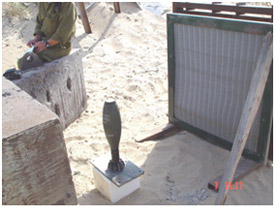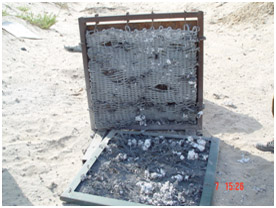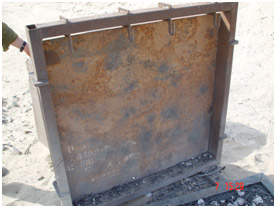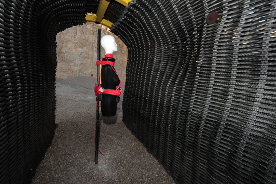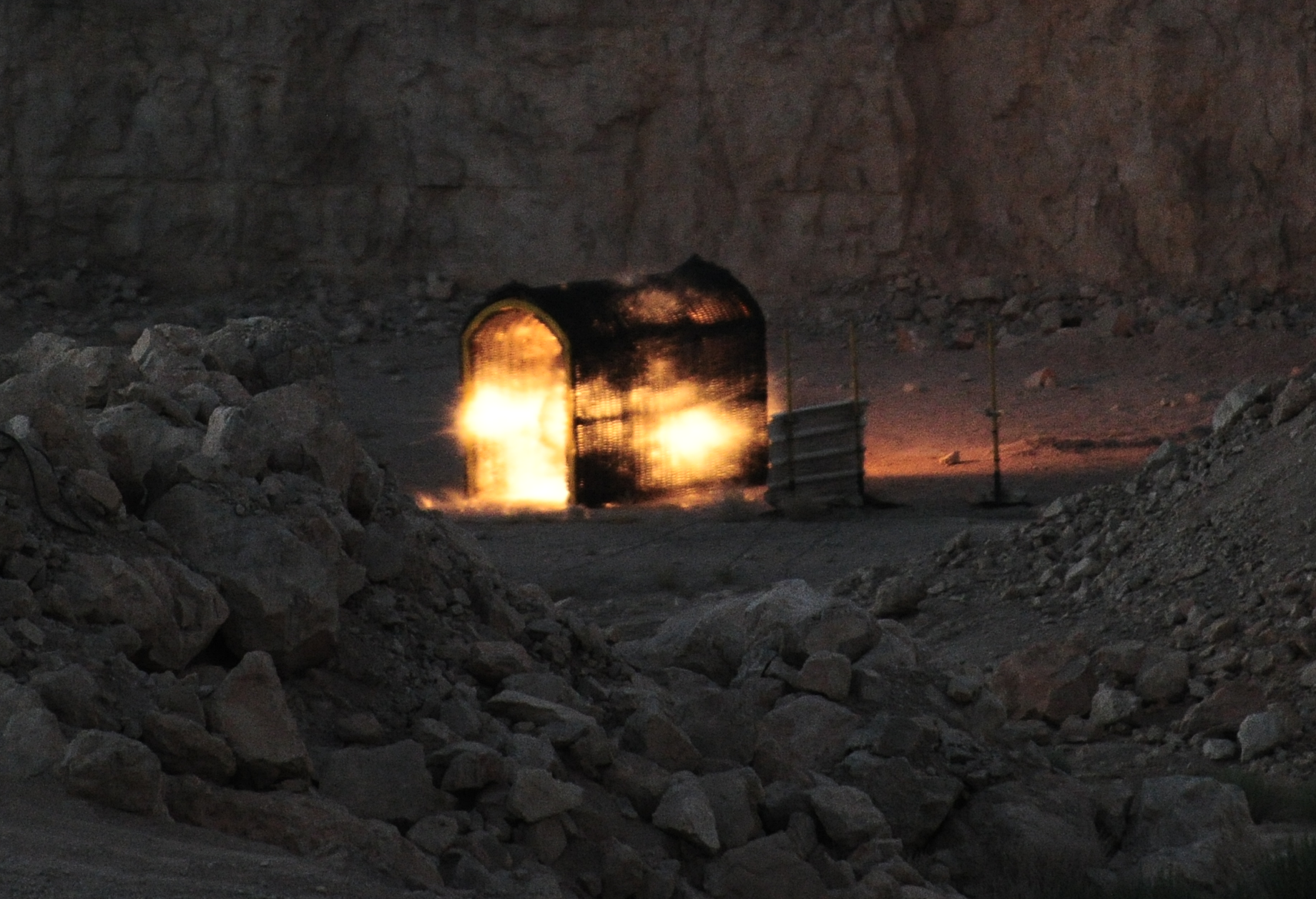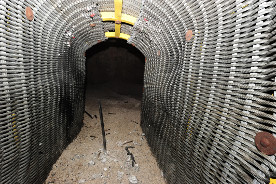At TM International, LLC, we're dedicated to providing industry-leading protection against over-pressure, flying debris and airborne dust and contaminants resulting from controlled explosions and catastrophic events. We have over 100 years of experience delivering superior-quality solutions that meet the highest standards of drilling blasting mat requirements.
TMI's Blast Shields have been tested from 1 to 130 Kg (of TNT) and all have the same conclusion: TMI has the ability to stop and reduce velocities of blast fragmentation while significantly reducing peak pressures.
All TMI products, including blast walls, SafePass blast shields and blast containment tanks are made from innovative new materials that have undergone rigorous testing and detailed scientific analysis. Its nominal thickness and flexibility makes it a true world leader. Additional benefits and advantages include a lightweight design that's simple to transport, install and remove, and long-term durability that delivers exceptionally low cost-per-use.
We assume the responsibility of ensuring TMI products are designed and manufactured to the most stringent drilling blasting mat requirements with the utmost seriousness and dedication. Take a moment to review the following data for a closer look at our successful history of testing and results.
Request Info
| Date | Purpose | Test | Results | |
|---|---|---|---|---|
| FEB 1995 | Checking for the US Army Corps of Engineers, blast curtains system, consisting of a cylindrical curtain + flat curtain on the top of the cylinder, for on-site munitions demolition. | Two spherical charges of C-4 high explosive (HE) were detonated inside the cylinder (equivalent to 2 lb and 4 lb of T.N.T.). | No damage was observed in the blast curtains. The peak of the reflected pressure measured on the blast curtains, for 4 lb of charge, was 9,000 psi over a duration of 0.3 msec. | PASS |
| FEB 1995 | Ballistic test | Simulated munitions of an 81mm mortar shell (fragments canon). Fragmentation velocities exceeded 5,900 feet per second. | Ballistic curtains are effective at slowing or stopping simulated 81mm munitions fragmentation. | PASS |
| SEP 1995 | Concept tests with bare high explosive and fragmenting munitions in a simulated demolition container. | Spherical charges of a C-4 HE 57 mm artillery round were detonated (separately) inside the above cylinder; the cylinder + flat top were inside a steel container (blast curtains used: models MB471 and MB121). | Bare of high explosives: Blast curtains are effective at mitigating shock pressures on the container walls; adding water bags behind the curtains seems to be effective at reducing the overall shock impulse on the container walls. 57MM artillery round: 5-20 fragments penetrated the double blast curtain system. Maximum depth penetration on witness steel plate: 0.3-0.35. | PASS |
| OCT 2002 | Testing a safe pass for checking point. The threat: suicide terrorist (car or explosive belts). The preliminary tests were conducted locally by the Israeli MOD R&D. | Detonation of a 120 mm HE mortar shell when a single system of double-layered blast curtains (1 m X 1 m, inner layer: diameter of steel wire 4mm, outer layer: 6 mm) was positioned at a distance of 1 m from the standing shell. A witness plate of armored steel was placed behind the blast curtains. | Inner layer: Severe damage. Outer layer: Moderate damage. No fragments penetrated the witness plate behind the two layers. The curtains were not reusable. | PASS |
| MAR 2013 | Testing the efficiency of Blast Containment Tank (BCT583F, made from 5/8" cable) that will act like an Sub Dividing Wall and separating each pile of explosives in such a way that no sympathetic detonation will occur. | The ammunition cans were filled with explosives (total explosive weight kg) and placed inside the basket; a bag full of ANFO (total explosive weight = 5 kg) was placed outside the basket (1 meter) for observation (of a sympathetic detonation). The detonation was made simultaneously with 4 electric detonators. Witness plates were placed at distances of 5, 10 and 15 meters from the basket. | No sympathetic detonation of the ANFO bag was observed. Most of the explosion energy was released toward the ground (making a small crater) and through the open air, without causing any detonation of the ANFO bag. The primary fragments remained in a basket, captured by the steel fibers of the net. Little evidence of fragmentation was found in the 5 m witness plate. No evidence of any fragmentation was found at the ranges of 10 m and 15 m. | PASS |
| JUN 2013 | Determine if the Blast Shield Walls (BSW1L12F & BSW2L10F)can block the primary fragmentation of an item with known data of its fragments. | The Blast Shield Walls were placed around three 155 mm ERFB-BB shells that were detonated simultaneously. The Blast Shield Walls were marked by the type and distance (for example: C10 for Type 1 placed 10 meters from the "Donor" and D15 for Type 2 placed 15 meters from the "Donor"). | Most of the fragments were scattered around the Blast Shield Walls (above and from the sides) and no evidence of high energy fragments (direct fragmentation) was found on the witness plates. All of the fragments that fell behind the BSWs were not consider by definition a "hazardous fragment". | PASS |
| JUN 2013 | Prove the ability of the Blast Shield Walls against higher mass fragmentation (car bomb). | The Blast Shield Walls were placed around a car bomb that was filled with more than 160 kg of ANFO (130 kg TNT equivalent). The Blast Shield Walls were marked by the type and distance (Blast Shield Walls were placed 5m, 10m and 15m from the car). | The fragments from the car were thrown in a radius of nearly 200 m (the engine was found 112 m from the detonation point). The explosion created a crater of over 1 m in depth. The fragments mass that were blocked by the Blast Shield Walls weighted up to 1.4 kg. Blast Shield Walls that were placed 5m and 10m collapsed. No evidence of fragments/debris was found on the witness plates behind the Blast Shield Walls. | PASS |
| JUN 2013 | Test the function of the Blast Shield Walls (BSW1L12F & BSW2L10F)as Sub Dividing Wall and the ability to prevent sympathetic explosion. | The Blast Shield Walls were placed one towards the other. The bare HE "Donor" was a bucket with 30 kg of TNT placed 1 meter above the ground. Another two bare HE charges ("acceptors") were placed behind the BSWs - one was a bag of TNT flakes and the other bare HE was placed on the second Blast Shield Wall itself. | No sign of sympathetic detonation was found in the test arena. Both charges ("acceptors") were found and the witness plates had no marks for detonation. | PASS |
| JUN 2013 | Prove the efficiency of two kinds of Blast Containment Tanks (BCT142F) in reducing pressure and stopping fragmentations (Blast Containment Tanks made from 1/4" cable). | The 1/4" Blast Containment Tak was placed in Arena 3 with the 60 mm M38A1 HE mortar bomb placed in the center of the Blast Containment Tank. | After the detonation, the Blast Containment Tank was disconnected from its base (bottom plate) and came apart. Although it was destroyed, only one fragment was found in one witness plate (5 meters) with a pressure reduction of more than 90% | PASS |



